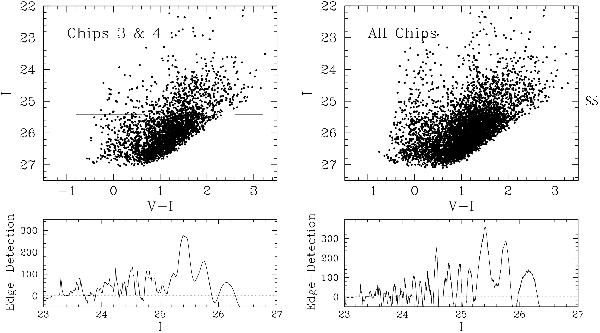Fig. 1

Color–magnitude diagrams in I versus (V − I) of an outlying WFPC2 field in M101 from Sakai et al. (2004, Fig. 11; note that the figure legend confuses M101 with NGC 3621). Left: only the stars in the outermost chips WF3 & WF4 with a prevailing halo population are shown. The TRGB is clearly visible at  . The edge detection spectrum (below) confirms the detection with high significance. Right: all stars in the WFPC2 field are plotted. The additional stars have smaller radial distances from M101 and comprise many evolved AGB stars and supergiants that populate the region above the TRGB. The TRGB is still detectable in the edge detection spectrum (below), but with much lower significance. The short horizontal bar denoted SS is where Shappee & Stanek (2011) have positioned the spurious TRGB for two inner, mixed-population fields of M101.
. The edge detection spectrum (below) confirms the detection with high significance. Right: all stars in the WFPC2 field are plotted. The additional stars have smaller radial distances from M101 and comprise many evolved AGB stars and supergiants that populate the region above the TRGB. The TRGB is still detectable in the edge detection spectrum (below), but with much lower significance. The short horizontal bar denoted SS is where Shappee & Stanek (2011) have positioned the spurious TRGB for two inner, mixed-population fields of M101.
Current usage metrics show cumulative count of Article Views (full-text article views including HTML views, PDF and ePub downloads, according to the available data) and Abstracts Views on Vision4Press platform.
Data correspond to usage on the plateform after 2015. The current usage metrics is available 48-96 hours after online publication and is updated daily on week days.
Initial download of the metrics may take a while.


